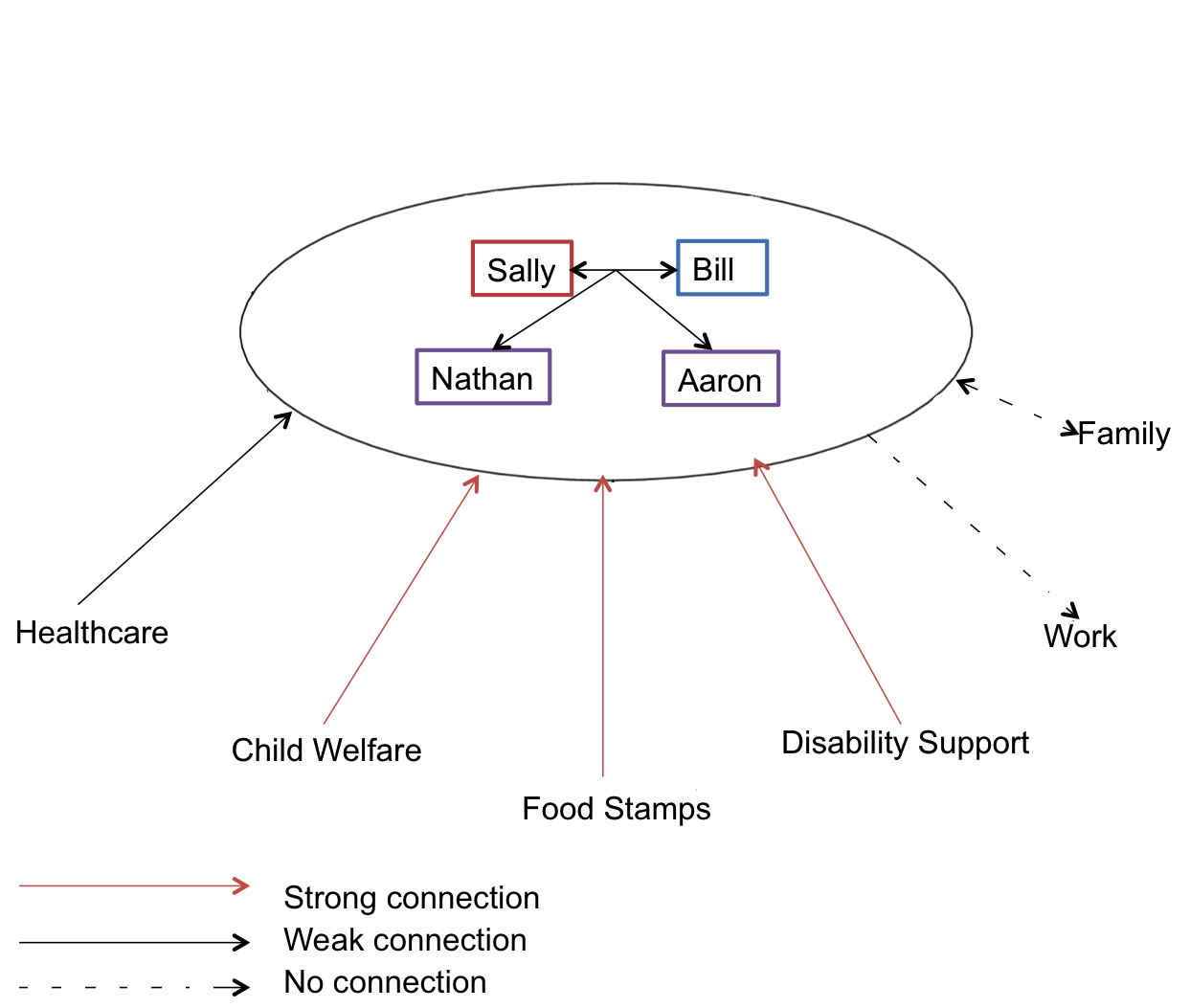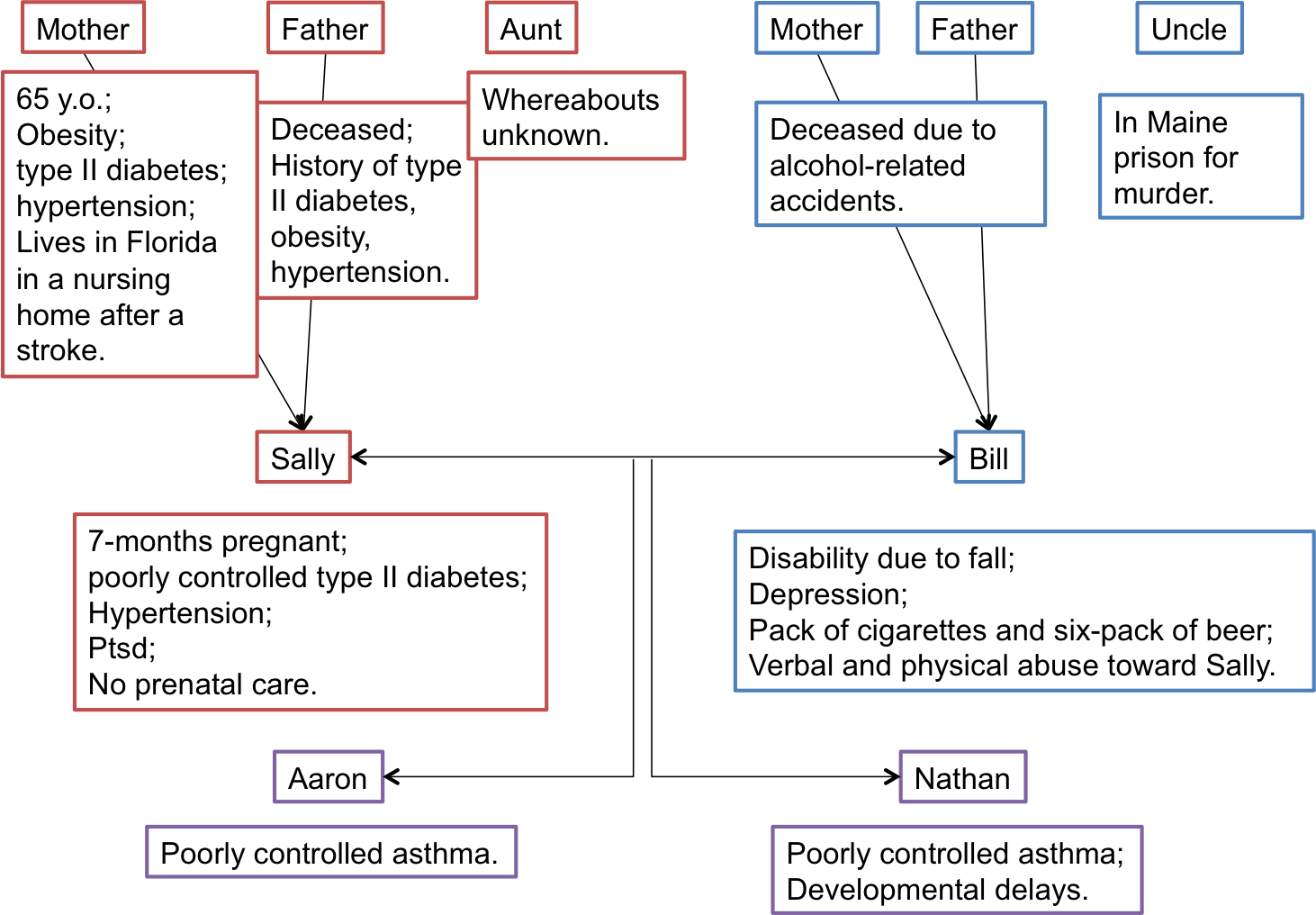Introduction
It was chosen to select a nuclear family in a low-income area for the present assessment. The choice was based on the fact that families that live in an environment that lacks resources for prosperity are more likely to have worse health outcomes compared to those who have access to financial resources that aid in their healthcare. The family consists of mother Sally (35 years old) who is seven months pregnant with a third child, father Bill (37 years old) who suffers from depression and physical disability, son Aaron (4 years old) with poorly controlled asthma, and son Nathan (3 years old) who also has asthma and delays in development.
Main body
It is evident that the family is currently at the parenting stage of their lifecycle, which means that both father and mother should learn how to adapt children into the relationships, ensure the healthy development of the younger generation, and have a strong relationship from which children can benefit (“Family life cycle – parenting: Babies through adolescents,” 2017). When it comes to the family’s environment, the family lives in a high-crime area and rents a three-bedroom house in poor condition due to the limited outcome that they receive from food stamps, children welfare, and Bill’s disability claim. In addition, the doctor’s office is located far from the family’s house, which makes it harder to take children for visits. This led to both Aaron and Nathan not seeing a physician. It is also important to mention that the bus is the primary method of transportation for the family and that children do not have any leisurely activities.
The family’s power structure is based on Bill making all decisions in the family while also controlling the financial aspect of the family’s life. It is important to note that Sally is passive when it comes to decision-making and does everything that her husband tells her to do. This can potentially lead to an imbalance within the family, especially since both parents do not work and rely heavily on benefits. Therefore, family functions are clear: Sally does all the shopping and cooking as well as taking care of children. Due to his physical disability, Bill stays at home and does not perform any household chores.
When it comes to the family assessed in the case study, extra attention should be paid to its mental health and coping mechanisms because they are directly related to the members’ well-being. Bill is struggling with depression due to his disability as well as drinking; it has been noted that he can be physically and verbally abusive toward his wife in a state of alcoholic intoxication. This problem is important to note because it directly affects other family members. Sally is also dealing with a mental issue of post-traumatic stress disorder associated with witnessing her father being murdered. Nathan has developmental delays, which also have the potential of affecting his mental capacity and coping. Overall, the family’s coping is on a low level, especially since Sally and Bill have a history of marital problems associated with poor coping and parenting. Possibly, many of the family’s issues arise due to Bill’s drinking habits because he often triggers the police being called. Also, he was charged with domestic violence, even furthering his negative reputation as a father. It can be advised for both Bill and Sally to seek help from a community mental health provider to address their struggles and prevent them from negatively affecting kids.
Financial problems are at the center of the family’s problems associated with both physical and psychological well-being. It has been noted that the family has minimal funds to provide children with toys, healthy food items, or medical assistance. The fact that Sally is seven months pregnant and did not have any prenatal care to make sure that the child is developing correctly. There is an ongoing theme in the family’s lack of ensuring appropriate care given to children – the younger son Nathan has developmental problems that may be attributed to poor parenting within the family. In addition, financial problems make it impossible for the family to buy healthy food such as fruit and vegetables that have a positive influence on child development and ensuring that they are healthy (Black & Hurley, 2013). Unhealthy snacks such as cookies, chips, and other junk food are regular for the family, which only contributes to the overall poor health.
Conclusion
Bill and Sally’s family is a bright example of many other families that live on the poverty line and lack motivation or resources to change the state of things for the better. The family should seek the support of community organizations that provide health, employment, and food assistance for low-income families. Oxfam America, Meals on Wheels, World Hunger Education & Advocacy, Child Care Food Program Roundtable, and many others are all organizations that can provide assistance to the family depending on its location (“99 great organizations confronting poverty and hunger,” n.d.). Key questions for additional information can include:
- Has Bill ever received any mental health assistance to deal with alcohol abuse?
- Are children taught basic reading and speaking skills?
- Has Sally had any complications during the present and past pregnancies?
- Is there any financial support from extended family?
- Has the family looking for work that Bill can do at home?
Family Ecomap and Genogram


References
Black, M., & Hurley, K. (2013). Helping children develop healthy eating habits. Web.
Family life cycle – parenting: Babies through adolescents. (2017).
99 great organizations confronting poverty and hunger. (n.d.). Web.